Insects in Firewood…Frequently Asked Questions
What Are Firewood Pests?
Firewood is a popular source of fuel in many homes today. Often firewood is cut from dying or storm-damaged trees that are extremely attractive to many insects, especially wood borers.
After wood is cut and stacked, it also can serve as a hiding place or overwintering area for a variety of other pests. Although most firewood pests pose no direct threat to the home, its contents, or its occupants, they can become annoying when they emerge inside the home. The following insects found inside the home may have originated with firewood.
Can I Learn More about Wood-Boring Beetles?
Long-horned beetles (also called roundheaded borers) are the most common of the wood borers that infest firewood. They lay eggs in wood while it is still green and thus are usually already in the wood when it is cut for firewood. Larvae are whitish, legless grubs that have bodies that taper from the head to the tail.
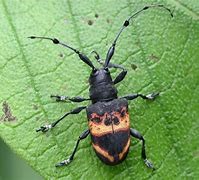
Courtesy of Learnaboutnature.com
They may tunnel and feed for a year or longer depending on the moisture content of the wood, and the temperature of its surroundings. After the larvae have pupated (resting stage), the adults may emerge from the wood and be found mating and dropping eggs again on freshly killed trees. Long-horned wood borers usually range from 1/2 to 1.5 inches in length, have antennae at least 1/2 as long as their bodies, and have long legs. Colors and particular markings vary greatly from species to species. Ash, oak, and hickory are among the most attacked woods, however, any wood in the right condition may be attacked. When firewood is stored indoors and temperatures are high, it is not unusual for the adult beetles to emerge, even during mid-winter. Although they may become a nuisance pest by their presence, they do not attack finished or dried wood inside the home.
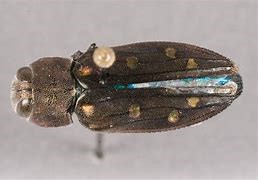
Flatheaded borers can also infest potential firewood. The larvae are similar in appearance and habits to the long-horned beetles. Tunnels made by the larvae are unique in that they are usually three times wider than high. Adults are flattened and somewhat elongate in shape with short antennae and legs. These beetles normally emerge during the summer months. They will not attack finished or dried wood. The bronze birch borer, one of the flatheaded wood borers, is occasionally found in homes where birch logs have been brought in for fireplace decoration.
A recently discovered pest of ash trees (Emerald Ash Borer) has the potential for serious destruction. Its spread into Indiana has been facilitated by the movement of firewood. For this and other reasons we recommend that firewood NOT be moved but rather used on site. For more information on the Emerald Ash Borer.
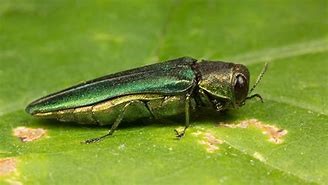
Courtesy of the University of Maine.
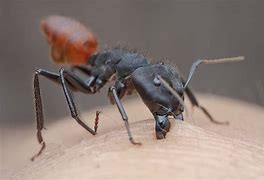
How About Carpenter Ants?
Firewood stacked on the ground for a long period of time or not allowed to dry out sufficiently can be subject to attack by carpenter ants. These large black or reddish ants may be up to 3/8 inch long. Bringing carpenter ant infested wood into the home generally will not spread the infestation inside the home. Only wood that is higher than normal in moisture content is susceptible to carpenter ant damage.
Are Termites a Concern?
Wood stacked on the ground can become infested with termites. Their presence is not usually noticed until the wood is moved during the summer or fall. Infested wood may have mud tunnels on the outside, or tunnels may be noticed if the wood is split. Termites may appear dormant during the winter months in these areas. Firewood should not be treated with insecticides. Termites accidently brought indoors with firewood will not infest structural wood. Their presence in firewood, piled close to the home, may warrant a home inspection for termites, however.
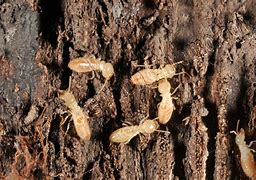
How Can I Control and Prevent These Pests from Entering My Home?
Homeowner should understand that nuisance insects will be brought into the home with firewood. Once warmed by the inside temperatures, they become active and may become nuisance pests. Recognizing them and knowing where they come from may reduce anxiety when homeowners are confronted with these pests. Homeowners should not make a practice of applying chemicals to firewood for pest control because of the possibility of harmful fumes being produced when the wood is burned. When control of existing pests becomes necessary, however, surfaces may be best treated by Millette Pest Control, to help reduce ants, spiders, and some other miscellaneous pests. There is little that can be done to protect wood from borers, and there are no practical controls for wood-boring larvae once they have entered the wood.
The following guidelines may be helpful in reducing firewood pests:
- Cut wood in mid- to late fall. This may make the wood less attractive to attack by borers that emerge in the spring.
- Bring firewood indoors only as needed, at most a couple of days supply at a time. Storing firewood in the home for long periods accelerates insect development inside the wood, which allows them to emerge inside the home.
- Do not stack wood up against the house or garage. This can result in moisture or insect problems in the building. A minimum of 3 feet between the firewood and building should be maintained. This also allows for better air circulation, which promotes more rapid and thorough drying of the wood.
- Stacking the wood off the ground whenever possible also will increase drying and reduce potential pest problems.
